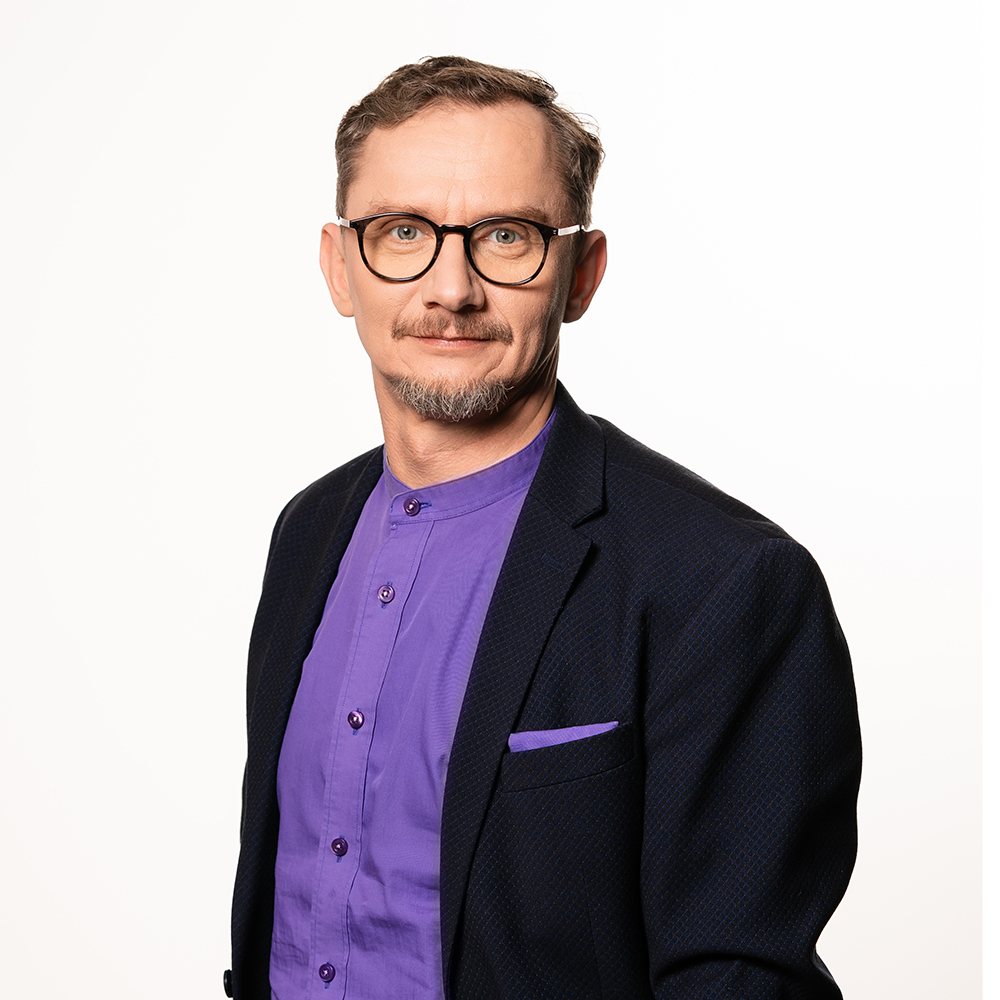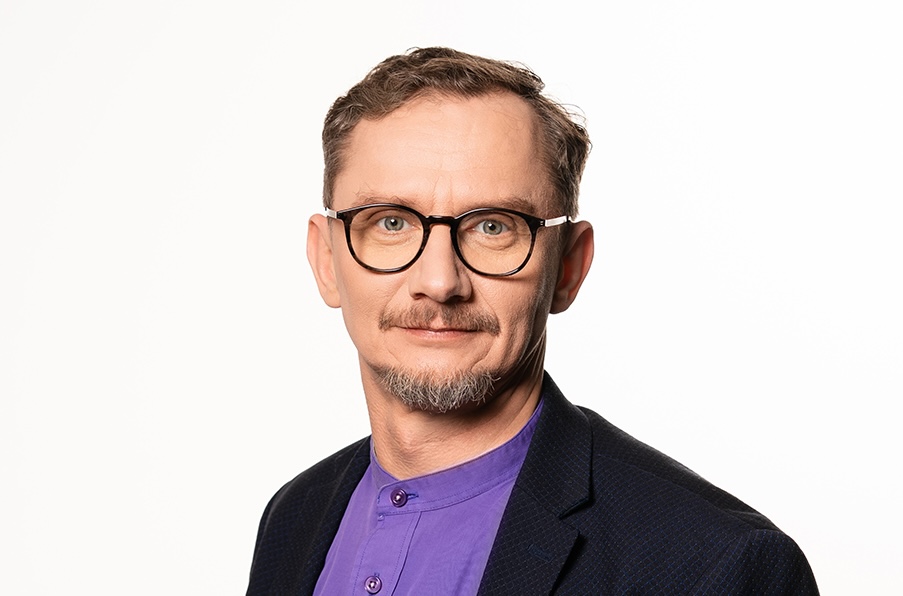Meet Indrek Tulp, a board member of Metrosert and head of its Applied Research Centre. With a background in computational chemistry and molecular technology, Indrek has dedicated years to advancing Estonian science into industry and international markets. We talk about his international career, the work of the applied research centre, motorcycles, horses—and electricity.

You have a fascinating field of expertise. Could you share your background and how you ended up at Metrosert?
My professional journey began at the Central Laboratory of the Health Protection Inspectorate (now the Health Board), where I analyzed heavy metals in water and food samples—a topic that also became the subject of my bachelor’s thesis. I later moved to a biotechnology company, where I worked with surface chemistry and developed DNA microarrays. That venture ended abruptly in 2003, which opened the door for new opportunities.
Since childhood, I’ve been interested in various technologies, especially computing. That led me to pursue a master’s in molecular technology, which overlaps with computational chemistry. During my studies, I spent a year and a half as a visiting researcher at the University of Florida in Professor Alan Roy Katritzky’s group, a renowned expert in heterocyclic organic compounds. There, I worked on both theoretical projects—such as a comprehensive analysis of solubility, which formed the basis of my thesis—and industry-related topics, including fuel additive analysis and mosquito repellents.
What is computational chemistry?
In essence, it’s modeling chemical processes using computers, based on the properties of substances. It can be ab initio—relying purely on quantum chemical theories—or semi-empirical, simplifying theory with experimental values. Computational chemistry explores everything from small fine chemicals to large protein systems and their interactions.
What happened after your time in Florida?
I returned to continue my PhD in the same field while also working in several companies. In 2009, I co-founded Selfdiagnostics OÜ, a medical device company that developed a portable, disposable, PCR-based rapid test for home use. Although privately owned, we worked closely with universities and secured multiple grants. We partnered with the University of Tartu, Tallinn University of Technology, Fraunhofer IZI in Germany, Dresden University of Technology, and several private companies. The total development cost reached about €20 million.
What came next after becoming an entrepreneur?
In 2019, I started studying business management at the University of Tartu, focusing on entrepreneurship and technology management, and graduated in 2020. I then worked at the Estonian Research Council, leading a resource valorization program. The key focus there was aligning scientific activity with the needs of the business sector. In 2023, I began building Metrosert’s Applied Research Centre.
You’ve worked on many different projects. Have you been involved in drug development as well?
Yes, I’ve participated in several drug development projects, including drug modeling and evaluation of properties like ADMET profiles (absorption, distribution, metabolism, elimination, and toxicity). My doctoral research focused on modeling chemical and biological properties of various compounds. Besides medical devices, I’ve also worked on biochemistry and biotechnology projects—for instance, using isothermal PCR with various peptides to analyze microorganisms. We’ve filed seven patent applications, two of which are internationally protected.
When did you first hear about plans to establish an applied research centre in Estonia?
I first heard about it around 2005, when it was still a very abstract idea. Later, under Minister Anne Sulling, the discussion became more serious, but for various reasons, the initiative stalled. The process finally gained momentum around 2022, by which time I was already working at the Estonian Research Council and involved in steering groups that were exchanging information on the topic.
Why do you think you were chosen to lead Metrosert’s Applied Research Centre?
Probably because I have experience from both academia and business—I’ve been a researcher and a technology development manager, and I’ve seen development projects through from start to finish. That’s important because the centre’s role is to serve as a bridge between universities and companies.
You’re approaching two years as head of the centre. How has it been?
It’s been a challenging but rewarding time—we’re building a long-term organization. Our mission is to address market failures that the private sector can’t tackle alone and to act as a development partner for many companies. It’s crucial that the centre remains independent and publicly owned, just like similar institutions in Finland (VTT), Sweden (RISE), and Norway (SINTEF).
What brings you the most joy in your daily work?
Definitely our team—people from diverse backgrounds who are all experts in their field, complementing each other and highly motivated. I’m also proud of Metrosert’s metrologists, certification experts, and administrative staff. We have many dedicated people whose eyes light up every day and who are committed to our mission.
President Alar Karis recently visited Metrosert—for the first time in the company’s history, if I’m not mistaken.
Yes, it was a significant event and shows that we matter to the Estonian state. The president’s questions and comments were thoughtful. He emphasized that Estonian scientific achievements need to reach markets at a much greater scale. While our universities and science are strong, a European Commission analysis shows that too little research makes it into industry. The Applied Research Centre was created precisely to address this gap.
“We have many dedicated people whose eyes light up every day and who are committed to our mission.”
How important is cooperation with universities for Metrosert?
It’s absolutely vital. We operate in between universities and industry, and work closely with both. We also contribute to human capital development—offering internships, scholarships, thesis topics, and even lectures when needed.
Where do you see Metrosert’s Applied Research Centre in ten years?
I hope we’ll be a strong European partner in our focus areas. Staying focused is key—you can’t do everything at once. But within our chosen domains, we aim to be top-tier and a reliable partner for both Estonian and international companies.
And where do you see yourself in ten years?
That’s hard to say. I prefer being part of an organization’s growth and building phase. Once it reaches full stability, I might not be the best fit as a leader anymore. But we’ll see—the field is constantly evolving, and new challenges keep emerging. Hopefully, I’ll continue to grow along with it.
Tell us a bit about your personal background—where are you from, and what do you do in your free time?
I was born in Tallinn, but around age 12, we moved to Võrumaa, where I graduated from Varstu Secondary School. I then went on to study chemistry at the University of Tartu, and since then I’ve lived and worked both in Estonia and abroad. I have two daughters—one is finishing kindergarten, and the other is in third grade. Our family’s big hobby is our summer home in Võrumaa. You could say that maintaining the countryside property and renovating old buildings is my main pastime. We also have a horse, and in the summer there are usually several more as companions. I also enjoy restoring old motorcycles—I have four Soviet-era bikes, two of which are roadworthy. In my spare time, I also like fishing and small construction projects.
Recently, for example, I assembled rustic-style picture frames from old wood and weathered fence boards. My wife’s drawings go into the frames, which we give as gifts—such as for kindergarten teachers or other special occasions. It’s a fun way to combine creativity, reuse, and family time.
Would you be able to manage without electricity in the countryside?
Sure—when the power goes out, we manage just fine. During COVID, we were in the countryside and barely noticed any difference. In fact, outages used to be so common there that we were used to it. Once, I even watched TV by candlelight—the TV was still working, but the lights were out. Living in the countryside means you learn to adapt to any situation.

Adding a special touch in the background is Kraaps, an Estonian Native Heavy horse.
